Microsoft RH-108 CDMA 850/1900 Cellular Phone User Manual RH 108 NonRUIM NAM Clean gold 09 08 07 FCC
Microsoft Mobile Oy CDMA 850/1900 Cellular Phone RH 108 NonRUIM NAM Clean gold 09 08 07 FCC
Manual
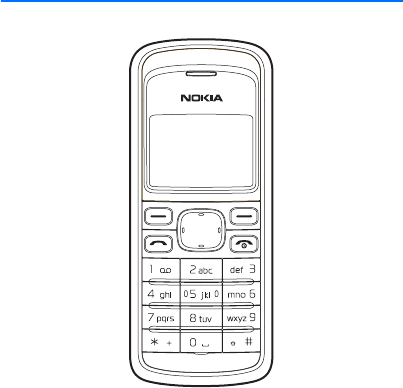
RH-108 User Guide

© 2007 Nokia. All rights reserved.
Nokia, Navi and Nokia Connecting People are trademarks or registered
trademarks of Nokia Corporation. Nokia tune is a sound mark of Nokia
Corporation. Other product and company names mentioned herein may be
trademarks or tradenames of their respective owners.
Reproduction, transfer, distribution, or storage of part or all of the
contents in this document in any form without the prior written
permission of Nokia is prohibited.
US Patent No 5818437 and other pending patents.
Includes RSA BSAFE cryptographic or security protocol software
from RSA Security.
Nokia operates a policy of ongoing development. Nokia reserves the right
to make changes and improvements to any of the products described in
this document without prior notice.
TO THE MAXIMUM EXTENT PERMITTED BY APPLICABLE LAW, UNDER NO
CIRCUMSTANCES SHALL NOKIA OR ANY OF ITS LICENSORS BE
RESPONSIBLE FOR ANY LOSS OF DATA OR INCOME OR ANY SPECIAL,
INCIDENTAL, CONSEQUENTIAL OR INDIRECT DAMAGES HOWSOEVER
CAUSED.
THE CONTENTS OF THIS DOCUMENT ARE PROVIDED "AS IS". EXCEPT AS
REQUIRED BY APPLICABLE LAW, NO WARRANTIES OF ANY KIND, EITHER
EXPRESS OR IMPLIED, INCLUDING, BUT NOT LIMITED TO, THE IMPLIED
WARRANTIES OF MERCHANTABILITY AND FITNESS FOR A PARTICULAR
PURPOSE, ARE MADE IN RELATION TO THE ACCURACY, RELIABILITY OR
CONTENTS OF THIS DOCUMENT. NOKIA RESERVES THE RIGHT TO REVISE
THIS DOCUMENT OR WITHDRAW IT AT ANY TIME WITHOUT PRIOR NOTICE.
The availability of particular products and applications for these products
may vary by region. Please check with your Nokia dealer for details, and
availability of language options.
Export controls
This device may contain commodities, technology, or software subject to
export laws and regulations from the US and other countries. Diversion
contrary to law is prohibited.
FCC/INDUSTRY CANADA NOTICE
Your device may cause TV or radio interference (for example, when using a
telephone in close proximity to receiving equipment). The FCC or Industry
Canada can require you to stop using your telephone if such interference
cannot be eliminated. If you require assistance, contact your local service
facility. This device complies with part 15 of the FCC rules. Operation is
subject to the following two conditions: (1) This device may not cause
harmful interference, and (2) this device must accept any interference
received, including interference that may cause undesired operation. Any
changes or modifications not expressly approved by Nokia could void the
user’s authority to operate this equipment.
xxxxxxx/Issue 1

Contents
Contents ................................................................................... 4
For your safety......................................................................... 6
General information .............................................................. 11
Access codes........................................................................................................... 11
Nokia support on the web.................................................................................. 11
1. Get started ......................................................................... 12
Install and remove battery ................................................................................. 12
Charge the battery................................................................................................ 14
Switch your phone on or off.............................................................................. 15
Normal operating position ................................................................................. 15
2. Your phone ........................................................................ 17
Keys and parts........................................................................................................ 17
Standby mode and shortcuts............................................................................. 18
Keyguard.................................................................................................................. 19
3. Call functions .................................................................... 20
Make and answer a call ...................................................................................... 20
Conference Calling ............................................................................................... 20
Loudspeaker............................................................................................................ 21
4. Write text........................................................................... 22
Traditional text input........................................................................................... 22
Predictive text input............................................................................................. 22
5. Menu functions ................................................................. 24
Contacts................................................................................................................... 24
Messages ................................................................................................................. 25
Call log ..................................................................................................................... 33
Profiles ..................................................................................................................... 34
Settings.................................................................................................................... 34
Gallery ...................................................................................................................... 42
Games....................................................................................................................... 43
Organizer ................................................................................................................. 43
Downloads............................................................................................................... 49
6. Enhancements.................................................................... 50
7. Reference information ...................................................... 52
Batteries and chargers......................................................................................... 52
Nokia battery authentication............................................................................ 54
Care and maintenance........................................................... 58
Additional safety information .............................................. 60
Index ....................................................................................... 70
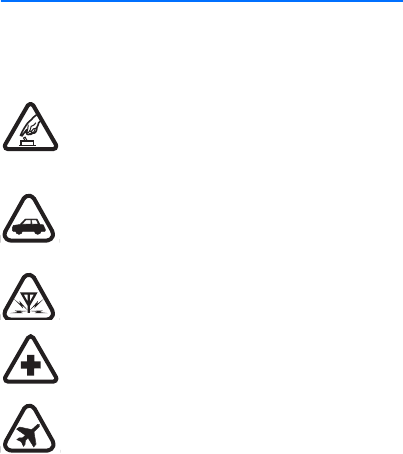
6
For your safety
Read these simple guidelines. Not following them may be
dangerous or illegal. Read the complete user guide for further
information.
SWITCH ON SAFELY
Do not switch the device on when wireless phone use
is prohibited or when it may cause interference or
danger.
ROAD SAFETY COMES FIRST
Obey all local laws. Always keep your hands free to
operate the vehicle while driving. Your first
consideration while driving should be road safety.
INTERFERENCE
All wireless devices may be susceptible to
interference, which could affect performance.
SWITCH OFF IN HOSPITALS
Follow any restrictions. Switch the device off near
medical equipment.
SWITCH OFF IN AIRCRAFT
Follow any restrictions. Wireless devices can cause
interference in aircraft.

7
SWITCH OFF WHEN REFUELING
Do not use the device at a refueling point. Do not use
near fuel or chemicals.
SWITCH OFF NEAR BLASTING
Follow any restrictions. Do not use the device where
blasting is in progress.
USE SENSIBLY
Use only in the positions as explained in the product
documentation. Do not touch the antenna areas
unnecessarily.
QUALIFIED SERVICE
Only qualified personnel may install or repair this
product.
ENHANCEMENTS AND BATTERIES
Use only approved enhancements and batteries. Do not
connect incompatible products.
WATER-RESISTANCE
Your device is not water-resistant. Keep it dry.
BACK-UP COPIES
Remember to make back-up copies or keep a written
record of all important information stored in your
device.

8
CONNECTING TO OTHER DEVICES
When connecting to any other device, read its user
guide for detailed safety instructions. Do not connect
incompatible products.
EMERGENCY CALLS
Ensure the phone function of the device is switched on
and in service. Press the end key as many times as
needed to clear the display and return to the standby
mode. Enter the emergency number, then press the call
key. Give your location. Do not end the call until given
permission to do so.
■About your phone
The wireless phone (RH-108) described in this guide is approved
for use on CDMA 800 and 1900 MHz, and CDMA 2000 1x RTT
network. Contact your service provider for more information
about networks.
When using the features in this phone, obey all laws and respect
local customs, privacy and legitimate rights of others, including
copyrights.

9
Copyright protections may prevent some images, music
(including ringing tones), and other content from being copied,
modified, transferred, or forwarded.
Warning: To use any features in this device, other than
the alarm clock, the device must be switched on. Do not
switch the device on when wireless device use may
cause interference or danger.
■Network services
To use the phone you must have service from a wireless service
provider. Many of the features require special network features.
These features are not available on all networks; other networks
may require that you make specific arrangements with your
service provider before you can use the network services. Your
service provider can give you instructions and explain what
charges will apply. Some networks may have limitations that
affect how you can use network services. For instance, some
networks may not support all language-dependent characters
and services.
Your service provider may have requested that certain features be
disabled or not activated in your device. If so, these features will
not appear on your device menu. Your device may also have a
special configuration such as changes in menu names, menu
10
order, and icons. Contact your service provider for more
information.
■Shared memory
The following features in this device may share memory:
Downloaded ring tones and wallpapers.
Use of one or more of these features may reduce the memory
available for the remaining features sharing memory. Your device
may display a message that the memory is full when you try to
use a shared memory feature. In this case, delete some of the
information or entries stored in the shared memory features
before continuing.

11
General information
■Access codes
The security and lock code controls access to features and
are supplied with the phone.
The phone lock feature protects your phone from
unauthorized outgoing calls or unauthorized access to
information stored in the phone.
When the phone lock is on, the only outgoing calls that
can be made are to the emergency number programmed
into your phone (for example, 911 or other official
emergency number).
Select Menu > Settings > Security settings to set how
your phone uses the access codes and security settings.
■Nokia support on the web
Check www.nokia.com/support or your local Nokia web
site for the latest version of this guide, additional
information, downloads, and services related to your
Nokia product.
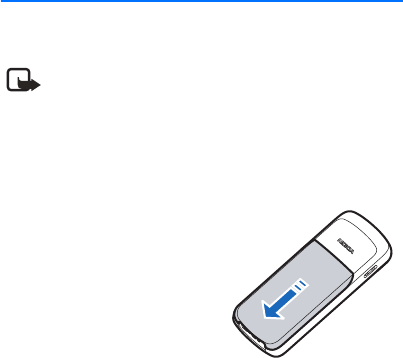
12
1. Get started
■Install and remove battery
Note: Always switch off the power and
disconnect the charger and any other device
before removing the cover. Avoid touching
electronic components while changing the cover.
Always store and use the device with the cover
attached.
1. To remove the cover, with
the back of the phone
facing you. Press and slide
the back cover toward the
bottom of the phone.
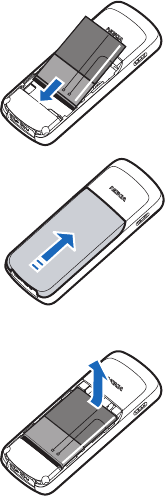
13
2. To insert the battery,
position the battery so the
gold-colored contacts
match up with those on the
phone, and insert the
battery into the battery
slot.
3. Push down on the other end
of the battery to snap the
battery into place.
4. Align the back cover with
the back of the phone, and
slide it toward the top of the
phone until you hear a click
to lock it into place.
5. To remove the battery,
remove cover (see step 1)
and insert your finger into
the finger grip, to lift the
battery from its
compartment.
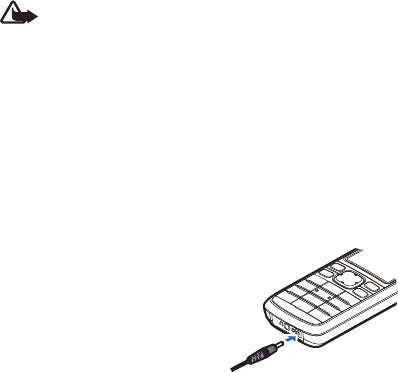
14
■Charge the battery
Warning: Use only batteries, chargers, and
enhancements approved by Nokia for use with this
particular model. The use of any other types may
invalidate any approval or warranty, and may be
dangerous.
This device is intended for use with a BL-5B battery and
AC-3 or AC-4 charger. For availability of approved
enhancements, please check with your dealer.
When you disconnect the power cord of any
enhancement, grasp and pull the plug, not the cord.
1. Connect the charger to a
wall socket.
2. Insert the charger output
plug into the round jack at
the bottom of the phone.
If the battery is completely
discharged, it may take a few
minutes before the charging indicator appears on the
display or before any calls can be made.
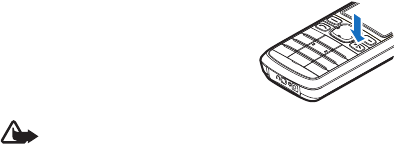
15
■Switch your phone on or off
To switch your phone on or off,
press and hold the power/end key
on the keypad for at least three
seconds.
Warning: Do not switch on
the phone when wireless phone use is prohibited
or when it may cause interference or danger.

16
■Normal operating position
Your device has an internal antenna. Hold the phone as
you would any other telephone with the antenna pointed
up and over your shoulder.
Note: As with any other radio
transmitting device, do not touch
the antenna unnecessarily when the
device is switched on. Contact with
the antenna affects call quality and
may cause the device to operate at
a higher power level than otherwise needed. To
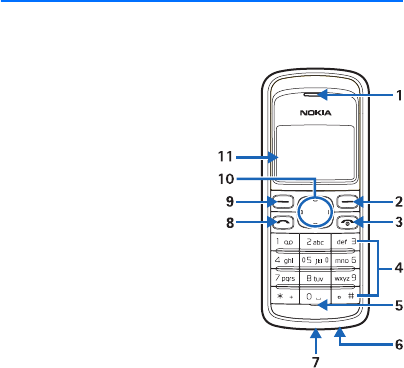
17
optimize antenna performance and battery life, avoid
contact with the antenna area when operating the device.
2. Your phone
■Keys and parts
1. Earpiece
2. Right selection key
3. Power/End key
4. Keypad
5. Microphone
6. Charger port
7. Headset port
8. Call key
9. Left selection key
10.Navi™ key (referred to as
scroll key)
11.Display screen

18
■Standby mode and shortcuts
Depending on your wireless service provider and the
model number of your device, some or all of the following
selection keys may appear in the standby mode.
At the start screen, your phone is idle and standing by for
activity.
1. Signal strength—A
higher bar indicates a
stronger network
signal.
2. Battery level—A higher
bar indicates more power in the battery.
3. Menu—Press the left selection key to enter the main
menu.
4. Contacts—Press the right selection key to enter
contacts list.
In the standby mode, the four-way scroll key may vary
with your network services. Please refer to your service
operator for detailed information.
Menu Contacts
19
■Keyguard
The keyguard locks the keypad to prevent keys from being
pressed and calls from being made accidentally.
To lock the keypad, select Menu, and press * within
2 seconds.
To unlock the keypad, select Menu, and press * within
2 seconds.
If the keypad is locked, it is unlocked automatically when
you receive a call. After the call, the lock automatically
reactivates. When the keyguard is on, calls may be
possible to the official emergency number programmed
into your phone.
In the standby mode, select Menu > Settings > Phone
settings > Automatic keyguard > On to set the keypad to
lock automatically after a preset time delay. Select Off to
deactivate the feature.

20
3. Call functions
■Make and answer a call
To make a call, enter the phone number, including the
country code and area code if necessary and press the call
key to call the number. Scroll right to increase or left to
decrease the volume of the earpiece or headset during the
phone call.
To answer an incoming call, press the call key. To end a
call, or reject an incoming all call without answering,
press the end key.
■Conference Calling
Conference calling is a network service that allows you to
take part in a conference call with another two
participants. To make a call to a new participant, select
Options > New call. Enter the number you want, and
press the call key. When the new call is answered, press

21
the call key to connect the calls. To end the conference
call, select Options > End all calls, or press the end key.
■Loudspeaker
You can use your phone as a loudspeaker during a call.
Warning: Do not hold the device near your ear
when the loudspeaker is in use because the
volume may be extremely loud.
To activate the loudspeaker during a call, select Loudsp..
To deactivate the loudspeaker during a call select
Handset.
The loudspeaker is deactivated automatically when a call
(or a call attempt) ends or when certain enhancements are
connected.

22
4. Write text
You can enter text using traditional or predictive
text input. To change the text input method,
and to switch between upper and lower case, press the #
key.
■Traditional text input
Press a number key, 1 to 9, repeatedly until the desired
character appears. To add a space, press 0. To add a
23
number, press and hold the desired number key. To get a
list of special characters, press *.
■Predictive text input
Predictive text input is based on a built-in dictionary
when writing in English. To turn it on:
Select Menu > Messages > Text messages > Create
message > Options > Prediction on; to turn it off, select
Prediction off.
When using predictive text input, press each key once for
a single letter. If * is displayed first, you need to press the
key to write another letter.
If the displayed word is the one you want, press 0, and
start writing the next word.
If your word is not displayed, press * repeatedly to view
other word options.
If ? is displayed after the word, the word is not in the
dictionary. To add the word to the dictionary, select Spell,

24
or select Options >Edit word, to enter the word (using
traditional text input), and select Save.
To get a list of special characters, press and hold *.
5. Menu functions
The phone functions are grouped into menus. Not all
menu functions or option items are described here.
In the standby mode, select Menu and scroll to the desired
menu item and press Select to enter a submenu. Press Exit
or Back to exit the current level of menu. Press the end key
to return to the standby mode directly.
■Contacts
The contacts list can hold up to 400 contacts with
multiple numbers and text notes for each contact. The

25
amount of numbers and text entries that you can save
may vary, depending on length and the total number of
entries in the contacts list.
To search for a contact, select Contacts > Search, enter
the first character of the contact name, and highlight the
contact you wish to view. Select Details > Options and
the action you want to apply to the contact.
Settings
Settings allows you to determine how your phone
numbers are viewed, and the memory status of contacts in
your phone.
1. Select Contacts > Settings.
2. To select how names and numbers are viewed in the
contacts list, select Scrolling view.
3. To view the amount of used and remaining memory in
the phone contacts, select Memory status.

26
■Messages
The message services can only be used when
they are supported by your network or service
provider.
Message settings
To edit your message sending settings, select Menu >
Messages > Text messages > Message settings >
Sending options and one of the following:
Message priority—to select the priority of the message as
Normal or Urgent.
Delivery note—a note is sent to you confirming delivery of
the message. Select On or Off.
Send callback number—to send a callback number, enter
the number you wish to be called back with. To not send a
callback number select Off.
For other settings, select Menu > Messages > Text
messages > Message settings > Other settings, and the
setting you wish to change:

27
Message font size—you can change the font size for
message reading and writing. Select Small font or Large
font.
Message overwriting—when the message memory is full,
your phone cannot receive any new messages. You can set
your phone to automatically overwrite old messages when
new ones arrive. To choose which messages can be
replaced, select Sent items only, Inbox only, or S. items &
Inbox or, to deactivate this feature, select Off.
Save to Sent items as sending—you can determine
whether messages should be saved automatically to the
Sent items folder when sent. Select Always save, Always
prompt or Off.
Queue msgs. when digital unavailable—you can store in
Outbox messages to be sent later when digital service is
available. Select On, On prompt, or Off.
Voice messages
Voice mail is a network service that must be activated by
your service provider. If you subscribe to voice mail, your
wireless provider will supply a voice mailbox number that

28
must be saved to your phone. For more details about voice
messages, contact your service provider.
To listen to your voice messages recorded in the voice mail
box, select Menu > Messages >Voice messages >Listen
to voice messages.
To access voice mail using speed dial, press and hold key 1.
Create message
1. Select Menu > Messages > Text messages > Create
message.
2. Compose a message using the keypad.
3. To send the message, in the message editor screen,
select Send to.
4. To send to one recipient, select Send to number. Enter
the recipient’s phone number; or select Search to
retrieve a number from your contacts. Select Send.
5. To send to many recipients, select Send to many.
Select Options >Add number to enter the recipient’s

29
phone number; or select Search to retrieve a number
from your contacts list. Select Send.
6. To send by e-mail, select Send to e-mail. Enter the
recipient’s e-mail address; or select Search to retrieve
an e-mail address from your contacts list. Select Send.
Note: Your device may indicate that your message
was sent to the message center number
programmed into your device. Your device may not
indicate whether the message is received at the
intended destination. For more details about
messaging services, contact your service provider.
Picture messages
Picture messages is a network service. If your wireless
service provider supports this feature, your phone comes
with five preloaded pictures. Pictures can be attached to a
text message and sent to compatible phones.
Note: The picture message function can be used
only if it is supported by your network operator or
service provider. Only compatible devices that
offer picture message features can receive and
display picture messages.
30
Copyright protections may prevent some pictures from
being copied, modified, transferred, or forwarded.
To send a picture message, do the following:
1. Select Menu > Messages > Text messages > Create
message.
2. Write a message (or enter nothing if you choose to just
send a picture), and select Options.
3. Select Insert picture.
4. Scroll down through the pictures, and select View.
5. Select Insert to insert the picture into your message;
otherwise select Back, scroll to another picture, and
select View again.
6. To send the picture message, select Send to > Send to
number, Send to many, or Send to e-mail.
7. Enter the phone number or e-mail address for your
recipient, or select Search to retrieve a number or e-
mail from the contacts list.
8. Select Send.
Picture images can only be received in text messages.

31
Read and reply
When you receive a message, a notification message is
displayed, and the icon appears.
1. Select Show to read the message or Exit to dismiss the
notification.
Scroll to view the whole message, if necessary.
When unopened messages are in your inbox, is
shown in the standby display mode as a reminder.
2. Select Reply > Empty screen, Original text, Template,
or other preset reply.
3. Enter your reply, and select Send.
Inbox, Sent items, and Drafts folders
All incoming messages are automatically stored in the
inbox.
Messages that are unsent and messages that failed to be
sent are automatically stored in the Outbox folder.
To save sent messages automatically to the Sent items
folder, select Menu > Messages > Text messages >
Message settings > Other settings > Save to Sent items

32
as sending and then select Always save or Always
prompt or Off to deactivate this feature.
You can store draft messages in the Drafts folder to edit
and send later. In the message editor screen, select
Options >Save message >Drafts.
Delete messages
If your message memory is full and you have more
messages waiting at the network, blinks in the standby
mode. You can read and delete read messages from some
of your folders.
To delete a single message, select Menu >Messages >
Text messages, choose the message and select Options >
Delete and OK to delete the message, or Back to exit.
To delete all messages in a folder, select Menu >
Messages > Text messages > Delete messages and one
of the following:
•All—choose Inbox, Outbox, Sent items, Drafts, or
Archive as the desired folder from which you want to

33
delete all messages. Select Done, and confirm the
deletion by pressing Yes at the confirmation note.
•All read—choose Inbox, Outbox, Sent items, Drafts, or
Archive as the desired folder from which you want to
delete all read messages. Select Done, and confirm the
deletion by pressing Yes at the confirmation note.
•All unread—delete any messages that have not been
read in the Inbox folder, and confirm the deletion by
pressing OK at the confirmation note.
■Call log
The Call log stores information about the last
20 missed, received, or dialed calls. It also adds
the total duration of all calls. When the number of calls
exceeds the maximum, the most recent call replaces the
oldest. The network must support these functions, and the
phone must be switched on and inside the network service
area.
Select Menu > Call log > Missed calls, Received calls, or
Dialed numbers to view the date and time of the call, edit,

34
view, or call the registered phone number; save it to
contacts; or delete it from the phone memory. You can
also send a text message.
You can delete any missed, dialed, or received calls from
phone memory. Select Menu > Call log > Delete recent
call lists > All, Missed, Received, or Dialed.
Select Menu > Call log > Call timers to view the
approximate duration of the last call, all received calls, all
dialed calls, life timer or all calls.
To reset the timers, select Menu > Call log > Call timers >
Clear timers, enter your security code, and select OK.
Note: The actual time invoiced for calls by your
service provider may vary, depending on network
features, rounding off for billing, and so forth.
■Profiles
Profiles defines for example how your phone
reacts when you receive a call or message, and
how your keypad sounds when you press a key. Ringing
options, keypad tones, and other settings for each of the
available profiles can be left at their default setting or

35
personalized to suit your needs. Available profiles are:
Normal, Silent, Meeting, Outdoor, and Pager.
To activate or customize a profile or set a timed expiration
for a profile, select Menu > Profiles, choose a profile and
select Activate, Customize, or Timed. You can also press
the end key and select to activate a profile (or Switch off!
to switch off the phone).
■Settings
In this menu, you can adjust various phone
settings. To reset menu settings to their default values,
select Menu > Settings > Restore factory settings. You
will be prompted to enter your security code before you
can proceed.
Call settings
Select Menu > Settings > Call settings and from the
following options:
Location info sharing—allows the sharing of your network
location so that your position maybe known. If activated it

36
can be set to on at all times, or only when emergency calls
are made.
Anykey answer—to answer an incoming call by briefly
pressing any key except the end key or right selection.
Automatic redial—to set your phone to redial a number
after an unsuccessful call attempt.
1-touch dialing—to select whether number keys (2-9) can
be used for one-touch dialing (calling a number by
pressing and holding a key).
Calling card—to save up to four calling card numbers in
your phone to use for long distance calls.
International prefix—to make calls using the + sign as the
international prefix. The phone replaces the + sign in a
saved phone number when creating a call.
Call summary—to display the time spent on a call when
you hang up.
Phone settings
Select Menu > Settings > Phone settings and from the
following options:

37
Phone language—to select the language for the display
text.
Automatic keyguard—to set the keypad to lock
automatically after a preset time delay.
Touch tones—to set the tone duration when you press the
keys on your phone keypad.
Welcome note—to write a welcome note that briefly
appears whenever you switch your phone on.
Banner—the default banner for your phone depends om
your network service. To change your banner select
Customize, enter the text you want displayed, and select
OK.
Help text activation—to display brief descriptions for
most menu items.
Time and date settings
Select Menu >Settings > Time and date settings and from
the available options:
Clock—to hide or show the clock, set the time, change the
time zone and format.

38
Date—to hide or show the date, set the date, change the
date format and date separator.
Auto-update of time & date—to have the time and date
updated automatically, select On. To update the time and
date only after your confirmation, select Confirm first. To
switch of the automatic update feature select Off.
Display settings
Select Menu > Settings > Display settings and from the
following options:
Wallpaper—to set a background image that is displayed
when the phone is in the standby mode.
Color schemes—to personalize the colors used on the
phone display.
Display brightness—to adjust the display brightness by
pressing the left and right scroll keys.

39
Backl. time-out—to control the backlight time-out of
your phone display.
Tone settings
All tone settings can only apply to the currently selected
profile.
Select Menu > Settings > Tone settings and from the
available options:
Incoming call alert—to set the alert type for incoming
calls.
Ringing tone—to set the tone for incoming calls.
Ringing volume—set the volume level for the ringing and
message alert tones, by adjusting the Ringing volume to
the volume of your preference. If you have your Ringing
option set to Ascending, and the Ringing volume set to
level 2 or above, your phone rings with the volume
ascending from level 1 to the level for incoming calls. If
you select the highest ringing tone level, the ringing tone
reaches its highest level after a few seconds.
Vibrating alert—to set the phone to vibrate when you
receive a call or a text message.

40
Message alert tone—to set the tone to sound when you
receive a text message.
Keypad tones—to select the volume level of the keypad
tones.
Warning tones—to control warning and confirmation
tones.
Alert for—to select that the phone gives an audible alert
only when a member of a selected caller group is calling.
Enhancement settings
To view compatible enhancements the phone can be
connected to, select Menu > Settings > Enhancement
settings > Charger, Hearing aid or Text phone.
Security settings
To set the security settings for your phone, the following
options are available:
Select Menu > Settings > Security settings > Call
restrictions or Access codes.

41
Network
The Network menu allows you to customize the way your
phone chooses a network in which to operate while you
are within or outside of your primary or home system.
Your phone is set to search for the most effective network.
If your phone cannot find a preferred network, it selects a
network automatically based on the option you choose in
the Network menu.
Select Menu > Settings > Network > Roaming options,
Roam call ringing tone or Service change tones.
The menu options you see in your phone are based on your
service provider’s network. The network determines which

42
options actually appear in the phone menu. Check with
your service provider for more information.
Network services
Displays available network services and their settings. For
the network service availability, please contact your
service provider.
Select Menu > Settings > Network services, and one of
the following options:
Network feature setting—to activate network services in
the phone by using feature codes received from your
service provider.
Own number selection—to activate network services in the
phone by using a number you have selected.
Restore factory settings
You can restore the original factory default settings
without affecting personal data such as contacts,
language selection, or calendar notes.
1. Select Menu > Settings > Restore factory settings.
2. Enter your security code and select OK.

43
■Gallery
You can use Gallery to manage your image
and audio files.
Images
Images can be used to personalize your phone. To display
a list of available images, select Menu > Gallery > Images
> Open. You can scroll through the images, select an
image and Options to Set as wallpap., Delete or view the
Details of the selected image file.
Tones
Tones can be used to personalize your phone. To display a
list of available tones, select Menu > Gallery > Tones.
Select a tone > Options and one of the following: Open—
to listen to the tone, Delete—to remove it, Set as ring tone,
Set as msg tone or Details to view the details of the tone.
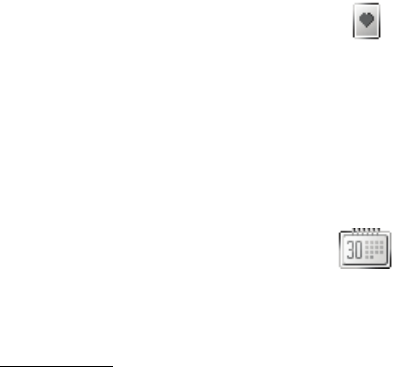
44
■Games
Some menus listed are network services.
Contact your service provider for more information.
In the standby mode, select Menu > Games > Select game
to display and play a game on your phone.
To adjust common game settings, select Menu > Games >
Settings. You can set the Game sounds, Game lights, or
Shakes for a game.
■Organizer
Your phone contains features to help organize
your everyday life, including an alarm clock, calendar,
calculator, countdown timer, stopwatch and .
Alarm clock
The alarm clock is based on the phone clock. It sounds an
alert any time you specify.

45
The alarm will still sound even when the device is
switched off.
To activate an alarm, select Menu > Organizer > Alarm
clock. Enter the time for the alarm in hh:mm format, and
select OK. Select am or pm if 12-hour clock format is on.
Alarm on appears briefly in the display, and appears in
the standby mode.
When the alarm sounds, your phone beeps, vibrates (if
vibrate alert is on in the currently active profile), and
lights up. When the alarm sounds, select Stop to shut the
alarm off or Snooze.
To turn off an alarm, select Menu > Organizer > Alarm
clock > Off.
Calendar
The calendar keeps track of reminders, calls you need to
make, meetings, memos, and birthdays. It can also sound
an alarm for these events.
The monthly view provides an overview of the selected
month and weeks. It also allows you to access a specific

46
date. Any dates that appear in bold font contain calendar
notes such as a meeting or reminder.
To open the calendar, scroll right or select Menu >
Organizer > Calendar. To go to a date, select Options in
the calendar view and Go to date, enter the date, and
select OK.
To note a specific date from the monthly view (with the go
to date highlighted), select Options > Make a note >
Meeting, Call, Birthday, Memo, or Reminder. Your phone
asks for further information depending on which note you
select.
Calculator
The calculator adds, subtracts, multiplies, divides,
calculates the square and the square root, changes the
sign (positive or negative) of the number entered, and
converts currency values.
Note: This calculator has a limited accuracy and is
designed for simple calculations.
1. Select Menu > Organizer > Calculator.
2. Enter the first number in the calculation.

47
Press # for a decimal point if necessary.
Press * to cycle through the add (+), subtract (-),
multiply (*), and divide (/) characters. Pause briefly to
select the displayed character.
3. Enter the second number in your calculation, press
Options > Equals to get the result.
To perform a square or square root calculation, select
Options > Square or Square root. Select Options >
Change sign, or scroll up or down to change the sign
(positive or negative) of your result.
Countdown timer
You can enter a specified time up to 99 hours, 59 minutes.
The timer starts to count down. When the timer reaches
zero, an alarm sounds.
The countdown timer only works when the phone is on.
When you turn off your phone, the timer is no longer
active.
To set the countdown timer, select Menu > Organizer >
Countdown timer. Enter the time, and select OK. Enter a
note for the timer, and select OK (in hh:mm).

48
Appears in the standby mode when the countdown
timer is set.
When the time runs out, your phone sounds an alarm,
displays a timer note, and flashes its lights.
Select Menu > Organizer > Countdown timer > Change
time to change the time and Stop timer to stop the timer
before the alarm sounds.
Stopwatch
Your phone has a stopwatch that can be used to track
time. The stopwatch displays time in hours, minutes,
seconds, and fractions of a second in hh:mm:ss.ss format.
Using the stopwatch, or allowing it to run in the
background when using other features, increases the
demand on battery power and reduces the battery life.
To use the split time or lap time functions for activities
where you need to time yourself, select Menu > Organizer
> Stopwatch > Split timing or Lap timing > Start.

49
If you press the end key and return to the standby mode,
the clock continues to run in the background, Appears
in the upper left corner of the screen.
To return to the stopwatch screen, select Menu >
Organizer > Stopwatch > Continue. To stop it, select
Stop.
Voice recorder
This feature allows you to record speech or sound with
your phone and listen to them later. The total available
time is 90 seconds if no recordings have been stored. The
maximum length of a recording depends on how much
memory remains available.
To record speech or sound, select Menu > Organizer >
Voice recorder > Record. Select Stop when you finish
recording. Enter a title for the recording, and select OK.
The recording is saved to the Recordings list.
After you have saved a recording to the recordings list,
you can select Options > Playback, Delete, Edit title, or
Add alarm.
50
■Downloads
The BREW application feature requires network support
and may not be available, or appear differently on your
phone depending on your network service provider. For
further information, please contact your service provider.
Mobile shop—to download applications to your mobile
phone. There are two options for finding an online
application: Catalog—allows you to browse by category,
and Search—to find applications using keywords.
Settings—provides management and system information
tools.
Help—get information about how to purchase and restore
applications, how to subscribe and cancel subscription of
applications, and information on charges.
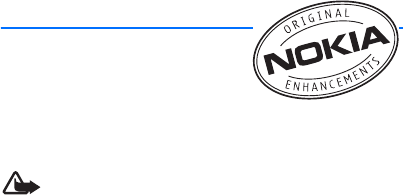
51
6. Enhancements
Check the model number of any
charger before use with this
device. This device is intended for
use when supplied with power from Nokia AC-3 or AC-4
charger.
Warning: Use only batteries, chargers and
enhancements approved by Nokia for use with this
particular model. The use of any other types may
invalidate any approval or warranty, and may be
dangerous.
A few practical rules about accessories and
enhancements:
• Keep all accessories and enhancements out of the
reach of small children.
• When you disconnect the power cord of any accessory
or enhancement, grasp and pull the plug, not the cord.

52
• Check regularly that enhancements installed in a
vehicle are mounted and are operating properly.
• Installation of any complex car enhancements must be
made by qualified personnel only.
Power
• Standard 860 mAh Li-Ion Battery (BL-5B)
• Compact Charger (AC-3)
• Travel Charger (AC-4)
• Car Power Adapter (DC-4)
Audio
• Headset (HS-9)
Warning: When using the headset your ability to
hear outside sounds may be affected. Do not use
the headset where it can endanger your safety.

53
7. Reference information
This section provides information about your phone
batteries, enhancements, chargers, safety guidelines and
technical information. Be aware that the information in
this section is subject to change as batteries, chargers,
and enhancements change.
■Batteries and chargers
Your device is powered by a rechargeable battery. The
battery can be charged and discharged hundreds of times,
but it will eventually wear out. When the talk and standby
times are noticeably shorter than normal, replace the
battery. Use only Nokia approved batteries, and recharge
your battery only with Nokia approved chargers
designated for this device. The use of any other types may
invalidate any approval or warranty, and may be
dangerous.
If a replacement battery is being used for the first time or
if the battery has not been used for a prolonged period, it
may be necessary to connect the charger, then disconnect
and reconnect it to begin charging the battery.
54
Unplug the charger from the electrical plug and the device
when not in use. Do not leave a fully charged battery
connected to a charger, since overcharging may shorten
its lifetime. If left unused, a fully charged battery will lose
its charge over time.
Use the battery only for its intended purpose. Never use
any charger or battery that is damaged.
Do not short-circuit the battery. Accidental short-
circuiting can occur when a metallic object such as a coin,
clip, or pen causes direct connection of the positive (+)
and negative (-) terminals of the battery. (These look like
metal strips on the battery.) This might happen, for
example, when you carry a spare battery in your pocket or
purse. Short-circuiting the terminals may damage the
battery or the connecting object.
Leaving the battery in hot or cold places, such as in a
closed car in summer or winter conditions, will reduce the
capacity and lifetime of the battery. Always try to keep
the battery between 59°F and 77°F (15°C and 25°C). A
device with a hot or cold battery may not work
temporarily, even when the battery is fully charged.
55
Battery performance is particularly limited in
temperatures well below freezing.
Do not dispose of batteries in a fire as they may explode.
Batteries may also explode if damaged. Dispose of
batteries according to local regulations. Please recycle
when possible. Do not dispose as household waste.
Do not dismantle or shred cells or batteries. In the event of
a battery leak, do not allow the liquid to come in contact
with the skin or eyes. In the event of such a leak, flush
your skin or eyes immediately with water, and seek
medical help.
■Nokia battery authentication
Always use original Nokia batteries for your safety. To
check that you are getting an original Nokia battery,
purchase it from an authorized Nokia dealer, look for the

56
Nokia Original Enhancements logo on the packaging and
inspect the hologram label using the following steps:
1. When looking at the hologram
on the label, you should see the
Nokia connecting hands symbol
from one angle and the Nokia
Original Enhancements logo
when looking from another
angle.
2. When you angle the hologram
left, right, down, and up, you
should see 1,2,3 and 4 dots on
each side respectivley.
3. Scratch the side of the label to
reveal a 20-digit code, for
example 12345678919876
543210. Turn the battery so that
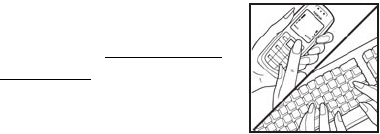
57
the numbers are facing upwards. The 20-digit code
reads from the number at the top row.
4. Confirm that the 20-digit code
is valid by following the
instructions at www.nokia.com/
batterycheck.
Successful completion of the four
steps is not a total assurance of the
authenticity of the battery. If you
have any reason to believe that your battery is not an
authentic original Nokia battery, you should refrain from
using it and take it to the nearest authorized Nokia service
point or dealer for assistance. Your authorized Nokia
service point or dealer will inspect the battery for
authenticity. If authenticity cannot be verified, return the
battery to the place of purchase.
What if you battery is not authentic?
If you cannot confirm that your Nokia battery with the
hologram on the label is an authentic Nokia battery,
please do not use the battery. Take it to the nearest
authorized Nokia service point or dealer for assistance.
The use of a battery that is not approved by the

58
manufacturer may be dangerous and may result in poor
performance and damage to your device and its
enhancements. It may also invalidate any approval or
warranty applying to the device. To find out more about
original Nokia batteries, visit www.nokia.com/battery.

59
Care and maintenance
Your device is a product of superior design and craftsmanship and
should be treated with care. The following suggestions will help
you protect your warranty coverage.
• Keep the device dry. Precipitation, humidity, and all types of
liquids or moisture can contain minerals that will corrode
electronic circuits. If your device does get wet, remove the
battery, and allow the device to dry completely before
replacing it.
• Do not use or store the device in dusty, dirty areas. Its moving
parts and electronic components can be damaged.
• Do not store the device in hot areas. High temperatures can
shorten the life of electronic devices, damage batteries, and
warp or melt certain plastics.
• Do not store the device in cold areas. When the device returns
to its normal temperature, moisture can form inside the
device and damage electronic circuit boards.
• Do not attempt to open the device other than as instructed in
this guide.
• Do not drop, knock, or shake the device. Rough handling can
break internal circuit boards and fine mechanics.

60
• Do not use harsh chemicals, cleaning solvents, or strong
detergents to clean the device.
• Do not paint the device. Paint can clog the moving parts and
prevent proper operation.
• Use only the supplied or an approved replacement antenna.
Unauthorized antennas, modifications, or attachments could
damage the device and may violate regulations governing
radio devices.
• Use chargers indoors.
• Always create a backup of data you want to keep, such as
contacts and calendar notes.
• To reset the device from time to time for optimum
performance, power off the device and remove the battery.
These suggestions apply equally to your device, battery, charger,
or any enhancement. If any device is not working properly, take it
to the nearest authorized service facility for service.
Note: Before sending your device to a service facility,
create a backup of data you want to keep such as
contacts and calendar notes.

61
Additional safety information
■Small children
Your device and its enhancements may contain small parts. Keep
them out of the reach of small children.
■Operating environment
This device meets RF exposure guidelines when used either in the
normal use position against the ear or when positioned at least
2.2 centimeters (7/8 inches) away from the body. When a carry
case, belt clip, or holder is used for body-worn operation, it
should not contain metal and should position the device the
above-stated distance from your body.
To transmit data files or messages, this device requires a quality
connection to the network. In some cases, transmission of data
files or messages may be delayed until such a connection is
available. Ensure the above separation distance instructions are
followed until the transmission is completed.
Parts of the device are magnetic. Metallic materials may be
attracted to the device. Do not place credit cards or other
magnetic storage media near the device, because information
stored on them may be erased.

62
■Medical devices
Operation of any radio transmitting equipment, including
wireless phones, may interfere with the functionality of
inadequately protected medical devices. Consult a physician or
the manufacturer of the medical device to determine if they are
adequately shielded from external RF energy or if you have any
questions. Switch off your device in health care facilities when
any regulations posted in these areas instruct you to do so.
Hospitals or health care facilities may be using equipment that
could be sensitive to external RF energy.
Pacemakers
Pacemaker manufacturers recommend that a minimum
separation of 15.3 centimeters (6 inches) be maintained between
a wireless phone and a pacemaker to avoid potential interference
with the pacemaker. These recommendations are consistent with
the independent research by and recommendations of Wireless
Technology Research. Persons with pacemakers should do the
following:
• Always keep the device more than 15.3 centimeters (6 inches)
from the pacemaker.
• Do not carry the device in a breast pocket.
• Hold the device to the ear opposite the pacemaker to
minimize the potential for interference.

63
If you suspect interference, switch off your device, and move the
device away.
Hearing aids
Some digital wireless devices may interfere with some hearing
aids. If interference occurs, consult your service provider.
■Vehicles
RF signals may affect improperly installed or inadequately
shielded electronic systems in motor vehicles such as electronic
fuel injection systems, electronic antiskid (antilock) braking
systems, electronic speed control systems, and air bag systems.
For more information, check with the manufacturer, or its
representative, of your vehicle or any equipment that has been
added.
Only qualified personnel should service the device or install the
device in a vehicle. Faulty installation or service may be
dangerous and may invalidate any warranty that may apply to
the device. Check regularly that all wireless device equipment in
your vehicle is mounted and operating properly. Do not store or
carry flammable liquids, gases, or explosive materials in the same
compartment as the device, its parts, or enhancements. For
vehicles equipped with an air bag, remember that air bags inflate
with great force. Do not place objects, including installed or
portable wireless equipment in the area over the air bag or in the
64
air bag deployment area. If in-vehicle wireless equipment is
improperly installed and the air bag inflates, serious injury could
result.
Using your device while flying in aircraft is prohibited. Switch off
your device before boarding an aircraft. The use of wireless
teledevices in an aircraft may be dangerous to the operation of
the aircraft, disrupt the wireless telephone network, and may be
illegal.
■Potentially explosive environments
Switch off your device when in any area with a potentially
explosive atmosphere, and obey all signs and instructions.
Potentially explosive atmospheres include areas where you would
normally be advised to turn off your vehicle engine. Sparks in
such areas could cause an explosion or fire resulting in bodily
injury or even death. Switch off the device at refueling points
such as near gas pumps at service stations. Observe restrictions
on the use of radio equipment in fuel depots, storage, and
distribution areas; chemical plants; or where blasting operations
are in progress. Areas with a potentially explosive atmosphere are
often, but not always, clearly marked. They include below deck on
boats, chemical transfer or storage facilities, and areas where the
air contains chemicals or particles such as grain, dust, or metal
powders. You should check with the manufacturers of vehicles

65
using liquefied petroleum gas (such as propane or butane) to
determine if this device can be safely used in their vicinity.
■Emergency calls
Important: Wireless phones, including this device,
operate using radio signals, wireless networks, landline
networks, and user-programmed functions. Because of
this, connections in all conditions cannot be
guaranteed. You should never rely solely on any wireless
device for essential communications like medical
emergencies.
To make an emergency call:
1. If the device is not on, switch it on. Check for adequate signal
strength.
2. Press the end key as many times as needed to clear the display
and ready the device for calls.
3. Enter the official emergency number for your present
location. Emergency numbers vary by location.
4. Press the call key.
If certain features are in use, you may first need to turn those
features off before you can make an emergency call. If the device
is in the offline or flight profile mode, you may need to change
the profile to activate the phone function before you can make an

66
emergency call. Consult this guide or your service provider for
more information.
When making an emergency call, give all the necessary
information as accurately as possible. Your wireless device may
be the only means of communication at the scene of an accident.
Do not end the call until given permission to do so.
■Certification information (SAR)
This mobile device meets guidelines for exposure to radio waves.
Use of device accessories and enhancements may result in
different SAR values. SAR values may vary depending on national
reporting and testing requirements and the network band.
Additional SAR information may be provided under product
information at www.nokia.com.
Your mobile device is also designed to meet the requirements for
exposure to radio waves established by the Federal
Communications Commission (USA) and Industry Canada. These
requirements set a SAR limit of 1.6 W/kg averaged over one gram
of tissue. The highest SAR value reported under this standard
during product certification for use at the ear is 1.28 W/kg and
when properly worn on the body is 0.64 W/kg. Information about
this device model can be found at http://www.fcc.gov/oet/fccid

67
by searching the equipment authorization system using FCC ID:
QMNRH-108.
Hearing aid compatibility
Your mobile device model complies with FCC rules governing
hearing aid compatibility. These rules require an M3 microphone
or higher value. The M-value shown on the device box, refers to
lower radio frequency (RF) emissions. A higher M-value generally
indicates that a device model has a lower RF emissions level,
which may improve the likelihood that the device will operate
with certain hearing aids. Some hearing aids are more immune
than others to interference. Please consult your hearing health
professional to determine the M-rating of your hearing aid and
whether your hearing aid will work with this device. More
information on accessibility can be found at
www.nokiaaccessibility.com.
■Technical information
Feature Specification
Dimensions Width 42.6 mm
Length 103.85 mm
Depth 16.57 mm
Weight 78 g with BL-5B Li-ion battery
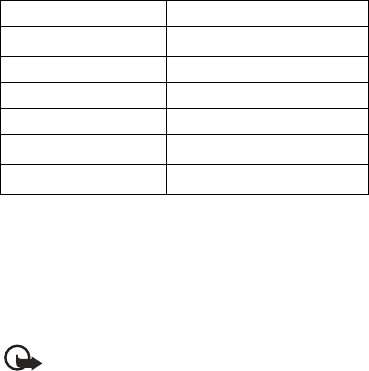
68
■Battery information
This section provides information about battery charging times
with the Compact Charger (AC-3), the travel charger (AC-4), and
talk and standby times. Be aware that the information in this
section is subject to change. For more information, contact your
service provider.
Important: Battery talk and standby times are
estimates only and depend on signal strength, network
conditions, features used, battery age and condition,
temperatures to which battery is exposed, use in digital
mode, and many other factors. The amount of time a
device is used for calls will affect its standby time.
Likewise, the amount of time that the device is turned
on and in the standby mode will affect its talk time.
Wireless networks CDMA 2000 1x RTT
Volume 73cc
PCS Frequency range (Tx) 1851.25~1908.75 MHz
PCS Frequency range (Rx) 1931.25~1988.75 MHz
Cell Frequency range (Tx) 824.70~848.31 MHz
Cell Frequency range (Rx) 869.70~893.31 MHz
Feature Specification
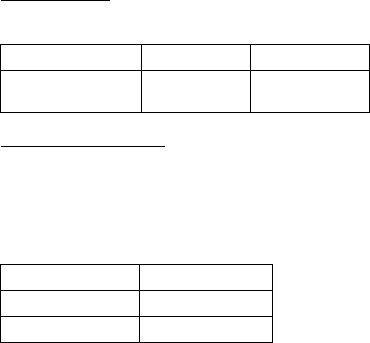
69
Charging times
The following charging times are approximate:
Talk and standby times
Operation times are estimates only and depend on signal
strength, phone use, network conditions, features used, battery
age and condition (including charging habits), temperatures to
which the battery is exposed, and many other factors.
Charger options AC-3 AC-4
BL-5B 860 mAh Li-Ion
battery
Up to 3.5 hours Up to 3 hours
Function Digital
Talk time Up to 3 hours 30 mins
Standby time Up to 10 days

70
Index
A
access codes 11
activate profile 34
alarm 43
B
batteries and chargers 52
battery
charging 14
charging times 68
talk times 68
C
calculator 45
calendar 44
calls
ending 20
making 20
care and maintenance 58
charger
connecting 14
information 52
times 68
contacts 24
countdown timer 46
D
default settings 41
dialed calls 33
E
enhancements 50
G
game 43
I
image files 42
K
keyguard
lock and unlock 19
L
loudspeaker 21
M
messages 25
71
delete 32
picture messages 29
voice messages 27
missed call 33
N
network 40
O
organize 43
P
phone settings 36
picture message 29
R
received call 33
recording 48
restore factory settings 41
roaming 40
S
safety 60
hearing aids 62
pacemaker 61
share memory 10
start screen 18
stopwatch 47
T
talk and standby times 68
technical information 67
tone files 42
turn phone on and off 15
V
voice
messages 27
recording 48